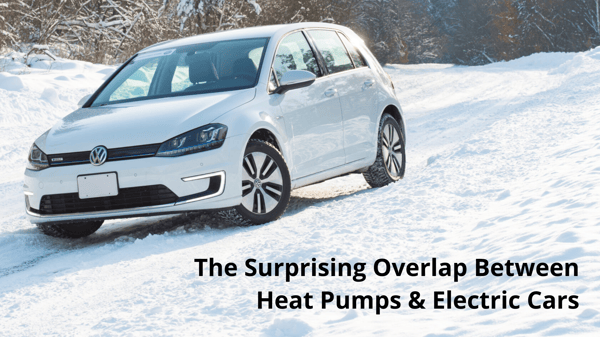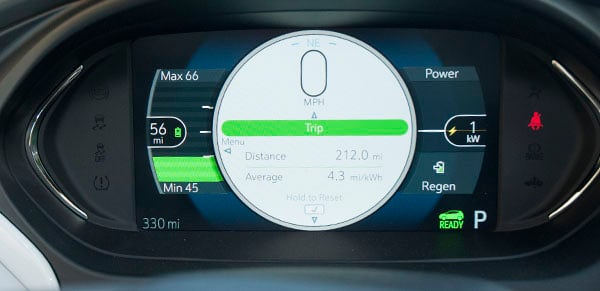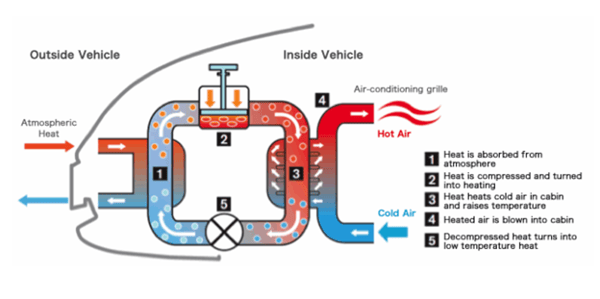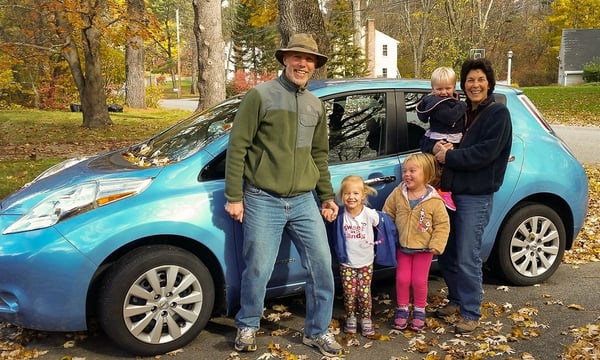 We at Green Energy Consumers Alliance like to connect the dots between technology, markets, and policy to help people make smart green energy choices. Electric cars help dramatically lower the carbon footprint of passenger vehicles, just as electric heat pumps replace the fossil fuels used to heat our homes; this is why we’re helping people to make the switch to both. But there’s an overlap between these two technologies that we find interesting and important.
We at Green Energy Consumers Alliance like to connect the dots between technology, markets, and policy to help people make smart green energy choices. Electric cars help dramatically lower the carbon footprint of passenger vehicles, just as electric heat pumps replace the fossil fuels used to heat our homes; this is why we’re helping people to make the switch to both. But there’s an overlap between these two technologies that we find interesting and important.
Springtime in New England is the perfect time to take a long drive in an electric car. At about 68 degrees, the lithium-ion batteries in electric cars operate most efficiently, so a full battery can translate to 300 driving miles in a car with an EPA-estimated range of 250 miles.

The EPA-estimated range is not a fixed number you’ll see whenever you’re charged to 100%. It’s an average that takes into account seasonal weather changes, and the actual number of miles you’ll drive on a full charge will vary according to driving conditions. Range estimators in electric cars are sophisticated enough to consider temperature, terrain, and speed into account on the dashboard to give the driver a more accurate estimate.
In general, moderate weather conditions will lead to much more range. When the temperature climbs in the summer sun or drops in the winter snow, energy stored within the battery must be used for heating or cooling itself. Every unit of energy that is used for the battery’s thermal management is a unit of energy that can’t be used to drive, which means fewer miles.
The impact of temperature on range is particularly noticeable in cold weather, when electricity stored in the battery must also be used to warm the air in the cabin to keep passengers comfortable. While gasoline-powered cars can rely on heat lost from the engine to help keep passengers warm, electric cars do not waste as much energy and must redirect energy from the battery to keep the car warm. Electric heaters are efficient, but keeping a car comfortable in a New England winter requires a lot of heat and therefore, a lot of electricity.
.jpg?width=600&name=Bruce%20Phillips%20Bolt%20Photo%20(2).jpg) Plenty of New England drivers manage cold weather range loss, including Bruce, the Bolt driver in Massachusetts pictured here. Here are some tips for extending range in the winter.
Plenty of New England drivers manage cold weather range loss, including Bruce, the Bolt driver in Massachusetts pictured here. Here are some tips for extending range in the winter.
In sunny and temperate California, where the majority of EVs in the United States are sold, driving range is consistent throughout the year. New England drivers, on the other hand, can lose as much as 30% of range on cold days. In a 250-mile-rated EV, a full charge could translate to less than 200 driving miles per charge when the temperature is low.
What is a heat pump?
Heat pumps are becoming increasingly popular to replace inefficient gas- or oil-burning furnaces for home heating. Heating and cooling for buildings is responsible for roughly one third of climate-warming emissions in Rhode Island and Massachusetts. Experts say that transitioning to heat pumps is crucial to dependence on fossil fuels. Our advocacy team is hard at work advocating for better policies to support heat pumps, and we ran a pilot program to help people upgrade their old heating systems. The advantages of heat pumps can be applied to electric car technology as well.
 Image source: Nissan
Image source: Nissan
Heat pumps don’t create heat like burning fossil fuels does; like an air-conditioner that can run in reverse, they move heat to make a space feel cooler in the summer and warmer in the winter. While electric resistive heating, more commonly used as a source of electric heating, is considered 100% efficient, a heat pump uses just one unit of electricity to move three units of heat. In other words, heat pumps consume a third of electricity while maintaining the same level of comfort.
So heat pumps are 300% efficient?
Yes and no.
Because of entropy and thermodynamics, it's impossible to be more than 100% efficient. That would mean you put 1 unit of energy in and get 3 units of energy out. It makes as much sense as this:
 Electric heaters are considered to be 100% efficient because they convert all of the electricity into heat. That's as good as you can get if you're trying to create heat. Usually other processes lose energy to heat by accident, when trying to do other energy-consumptive tasks.
Electric heaters are considered to be 100% efficient because they convert all of the electricity into heat. That's as good as you can get if you're trying to create heat. Usually other processes lose energy to heat by accident, when trying to do other energy-consumptive tasks.
But the key to understanding heat pumps is that they don't create heat, but move heat. And it turns out that you can move heat with less electricity than it takes to create heat, so heat pumps accomplish what we want (a toasty warm car cabin) without burning through as much energy.
Engineers don’t like to say that something is more than 100% efficient, so for heat pumps the better term to use is “coefficient of performance” or COP. Something that is 100% efficient has a COP of 1. With heat pumps, the COP varies between 1 and 4. This means it’s more efficient at heating space than burning a fuel.
Like lithium-ion batteries and gasoline engines, heat pumps are less efficient in cold weather because it’s difficult to move heat on a 30-degree day. This makes heat pumps slow to start in the cold, compared to the near-instant warming effect of resistive heating. But when a car’s energy needs are high in the wintertime, heat pumps drastically diminish energy consumption and therefore extend cold weather driving range by as much as 30% compared to the electric heating units used in most EVs today.
Which electric cars use heat pumps?
Although heat pumps are advantageous for extending cold-weather range, they don’t actually increase the stated EPA-estimated range of a vehicle because the EPA’s testing cycle for EVs does not test the impacts of cabin-heating, the biggest energy suck during the winter, during its cold weather test. The benefits of heat pumps are hidden from consumers comparing fuel efficiency stickers on EVs, leaving automakers to weigh performance against higher cost and complexity.
 "I have had plenty of opportunity to drive the LEAF in bitter cold as well as blistering heat, and have never been disappointed with the car's performance." - Debby, Nissan LEAF owner
"I have had plenty of opportunity to drive the LEAF in bitter cold as well as blistering heat, and have never been disappointed with the car's performance." - Debby, Nissan LEAF owner
While most, if not all electric cars come with features like seat- and steering wheel-heaters to keep passengers warm without using as much energy, the heat pump has been more elusive among the most popular EV models. Nissan has offered heat pumps as part of “all-weather” vehicle packages for the LEAF since 2013. While the Kia Niro EV comes standard with a heat pump, the Chevrolet Bolt and the US-market Hyundai Kona do not offer it at all. Most recently, Tesla made a splash by announcing that the upcoming Model Y will be the first Tesla model to include a heat pump.
It will be interesting to see whether the carmakers and the overall market “decide” to alleviate cold weather range anxiety by putting in heat pumps, increasing the overall average range, or both. We would like to see both and expect that heat pumps will become more prevalent as an option or even as a standard feature in all-electrics. We have not seen details on how much a heat pump would add to the cost of an EV, but we suspect that the cost will come down as more units are sold.
There are easy ways to manage cold-weather range loss, even if your EV doesn’t have a heat pump. Several countries with more severe winters than New England, such as Canada and Norway, are charging ahead with electric vehicle adoption. If they can do it there, why not here?

 A generous donor will match up to $10k through September 30th. With your help, we could raise $20,000 for climate and clean energy!
A generous donor will match up to $10k through September 30th. With your help, we could raise $20,000 for climate and clean energy!
 We at Green Energy Consumers Alliance like to connect the dots between technology, markets, and policy to help people make smart green energy choices. Electric cars help dramatically lower the carbon footprint of passenger vehicles, just as electric heat pumps replace the fossil fuels used to heat our homes; this is why we’re helping people to make the switch to both. But there’s an overlap between these two technologies that we find interesting and important.
We at Green Energy Consumers Alliance like to connect the dots between technology, markets, and policy to help people make smart green energy choices. Electric cars help dramatically lower the carbon footprint of passenger vehicles, just as electric heat pumps replace the fossil fuels used to heat our homes; this is why we’re helping people to make the switch to both. But there’s an overlap between these two technologies that we find interesting and important.
.jpg?width=600&name=Bruce%20Phillips%20Bolt%20Photo%20(2).jpg)

 Electric heaters are considered to be 100% efficient because they convert all of the electricity into heat. That's as good as you can get if you're trying to create heat. Usually other processes lose energy to heat by accident, when trying to do other energy-consumptive tasks.
Electric heaters are considered to be 100% efficient because they convert all of the electricity into heat. That's as good as you can get if you're trying to create heat. Usually other processes lose energy to heat by accident, when trying to do other energy-consumptive tasks. "I have had plenty of opportunity to drive the LEAF in bitter cold as well as blistering heat, and have never been disappointed with the car's performance." - Debby, Nissan LEAF owner
"I have had plenty of opportunity to drive the LEAF in bitter cold as well as blistering heat, and have never been disappointed with the car's performance." - Debby, Nissan LEAF owner

Comments